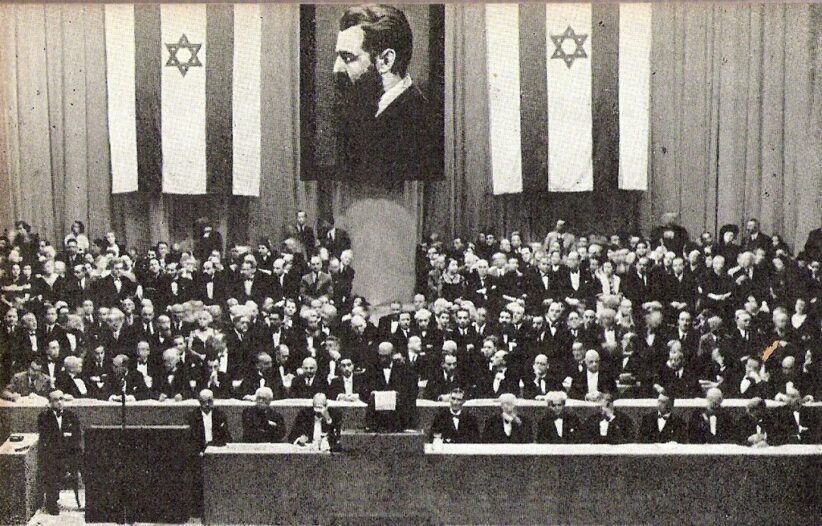The historical background of the Israeli-Palestinian conflict goes back to 1917 (the Balfour Declaration) and the establishment of the British protectorate over Palestine (the Palestine Mandate) after WWI with its provision for a national home for the Jews, although formally not to be at the expense of the local inhabitants – the Palestinians. Nevertheless, it became in practice the focal problem to keep an appropriate balance between these stipulations to be acceptable to both sides – the Jews and the Palestinians.
The people and the land
Since the time of the Enlightenment followed by Romanticism, in Western Europe emerged a new trend of group identification of the people as ethnic or ethnocultural nations different from the previous feudal trends from the Middle Ages based on religion, state borders, or social strata belonging.
1 Over time, a new trend of people’s identification as a product of the capitalistic system of production and social order became applied across the globe following the process of capitalistic globalization.
2 As a direct consequence of such development of the group identities, the newly understood nations, especially in the areas under colonial foreign rule, started to demand their national rights but among them, the most important demand was the right to self-rule in a nation- state of their own. In other words, the ethnic or ethnic-confessional groups under foreign oppression demanded the rights of self-determination and political sovereignty.
3 Since around 1900, both the Jews and the Arab-Palestinians became involved in the process of developing ethnonational consciousness and mobilizing their nations for the sake of achieving national-political goals. However, one of the focal differences between them regarding the creation of a nation-state of their own was that the Jews have been spread out across the world (a diaspora) since the fall of Jerusalem and Judea in the 1 st century AD
4 while, in contrast, the Palestinians were concentrated in one place – Palestine. From the very end of the 19 th century, a newly formed Th. Herzl’s Zionist movement had a task to identify land where the Jewish people could immigrate andsettle to create their own nation-state. For Th. Herzl (1860‒1904),
5 Palestine was historically logical as an optimal land for the Jewish immigrants as it was the land of the Jewish states in the Antique.
6 It was, however, an old idea, and Th. Herzl in his book pamphlet which became the Bible of the Zionist movement was the first to analyze the conditions of the Jews in their assumed to be “native” land and call for the establishment of a nation-state of the Jews in order to solve the Jewish Question in Europe or better to say to beat traditional European anti-Semitism and modern tendency of the Jewish assimilation. But the focal problem was to somehow convince the Europeans that the Jews had the right to this land even after 2.000 years of emigration in the diaspora.
However, what was Th. Herzel’s Eretz Yisrael in reality? For all Zionists and the majority of Jews, it was the Promised Land of milk and honey but in reality, the Promised Land was a barren, rocky, and obscure Ottoman province since 1517 settled by the Muslim Arabs as a clear majority population. On this narrow strip of land of East Mediterranean, the Jews, and the Arab Palestinians lived side by side at the time of the First Zionist Congress some 400.000 Arabs and some 50.000Jews.
7 Most of those Palestinian Jews have been bigot Orthodox 8 who entirely depended on their
existence on charitable offerings of different Jewish societies in Europe which have been distributed
to them by the communal organizations set up mainly exactly for that purpose.
Palestine is a historic land in the Middle East on the eastern coast of the Mediterranean Sea between the River of Jordan and the Mediterranean seacoast. Palestine is called Holy Land by the Jews, Christians, and Muslims because of its spiritual links with Judaism, Christianity as well as Islam. The land experienced many changes and lordships in history followed by changes of frontiers and its political status. For each of the regional denominations, Palestine contains several sacred places. In the so-called biblical times, on the territory of Palestine, the Kingdoms of Israel and Judea existed until the Roman occupation in the 1 st century AD. The final wave of Jewish expulsion to the
diaspora from Palestine started after the abortive uprising of Bar Kochba in 132−135. Up to the emergence of Islam, Palestine historically was controlled by the Ancient Egyptians, Assyrians, Persians, the Roman Empire, and finally by the Byzantine Empire (the East Roman Empire) alongside the periods of the independence of the Jewish kingdoms.
The land became occupied by the Muslim Arabians in 634 AD. Since then, Palestine has been populated by a majority of Arabs, although it remained a central reference point to the Jewish people in the diaspora as their “Land of Israel” or Eretz Yisrael. Palestine remained under Muslim rule up to WWI, being part of the Ottoman Empire (1516−1917), when combined the Ottoman and German armies became defeated by the Brits at Megiddo, except for the time during the West European Crusades from 1098 to 1197. 9 The term Palestine was used as the official political title for
the land westward of the Jordan River mandated in the interwar and post-WWII period to the United Kingdom (from 1920 up to 1947). However, after 1948, the term Palestine continues to be used, but now in order to identify rather a
geographical than a political entity. It is used today, particularly in the context of the struggle over
the land and political rights of Palestinian Arabs displaced since Israel became established. 10
The Jewish migrations to Palestine in 1882−1914
As a consequence of renewed pogroms in East Europe in 1881, the first wave of Jewish immigration into Palestine started in 1882 followed by another wave before WWI from 1904 to 1914. 11 The immigration of the Jewish settlers was encouraged by the 1917 Balfour Declaration, and very much intensified since May 1948 when the Zionist State of Israel was proclaimed and established.
There were historically two types of motives for the Jews to come to Eretz Yisrael (In Hebrew, the “Land of Israel”):
1. The traditional motive was prayer and study, followed by death and burial in the holy soil.
2. Later, since the mid-19 th century, a new type of Jew being secular and in many cases idealistic began to arrive in Palestine but many of them have been driven from their native lands by anti-Semitic persecution.
In 1882 there was the first organized wave of European Jewish immigration to Palestine. Since the 1897 First World Zionist Congress in Basel, there was an inflow of European Jews into Palestine especially during the British Mandate time followed by the British-allowed policy of land-buying by the Jewish Agency which was, in fact, indirect preparation for the creation of the Jewish nation- state – Israel. 12 In other words, such a policy was designed to alienate land from the Palestinians, stipulating that it could not be in the Arab hands.
3. Even before the First Zionist Congress in Basel, Th. Herzl tried to recruit prosperous and rich Jews (like the Rothschild family) to finance his plan of the Jewish emigration and colonization of Palestine but finally failed in his attempt. Th. Herzl decided to turn to the little men – hence his decision to convene the 1897 Basel Congress where according to his diary, he founded the Jewish state. After the congress, he did not waste time in turning his political program into reality. Still, at the same time, he strongly disagrees with the idea of peaceful settlement in Palestine, or according to his own words “gradual Jewish infiltration”, which, in fact, already started even before the
meeting of the Zionists in Basel.
At that time, Palestine as an Ottoman province did not constitute a single political-administrative unit. The northern districts have been parts of the province of Beirut, and the district of Jerusalem was under the direct authority of the central Ottoman Government in Istanbul because of the international significance of the city of Jerusalem and the town of Bethlehem as religious centers equally important for Islam, Judaism, and Christianity. 13 A vast majority of the Arabs either Muslims or Christians have been living in several hundred villages in a rural environment.
Concerning the town settlers of Arab origin, the two biggest of them were Jaffa and Nablus together with Jerusalem as economically the most prosperous urban settlements. 14 Until WWI, the biggest number of Palestinian Jews was living in four urban settlements of the most important religious significance to them: Jerusalem, Hebron, Safed, and Tiberias. They have been followers of traditional, Orthodox religious practices spending much time studying religious texts and depending on the charity of world Jewry for survival. 15 It has to be noticed that their attachment to Eretz Yisrael was much more of religion than of national character and they were not either involved in or supportive of Th. Herzl’s Zionist movement emerged in Europe and was, in fact, brought to Palestine by the Jewish immigrants after 1897. However, most of the Jewish immigrants to Palestine after 1897 who emigrated from Europe have lived of secular type of life having commitments to the secular goals to create and maintain a modern Jewish nation based on the European standards of the time and to establish an independent Jewish state – modern Israel but not to re-establish a biblical one. During the first year of WWI, the total number of Jews in Palestine reached some 60.000 of whom some 36.000 were settlers since 1897. On the other hand, the total number of the Arab population in Palestine in 1914 was around 683.000.
The second wave of Jewish immigration to Palestine (1904−1914) had many intellectuals and middle-class Jews but the majority of those immigrants have been driven less by a vision of a new state than by the hope of having a new life, free of pogroms and persecutions.









